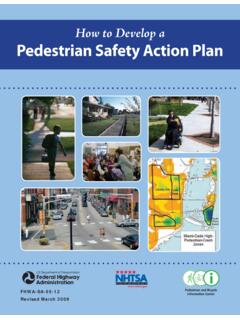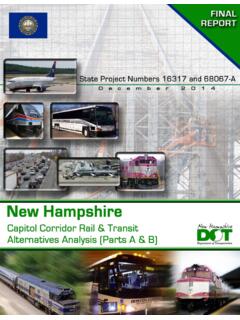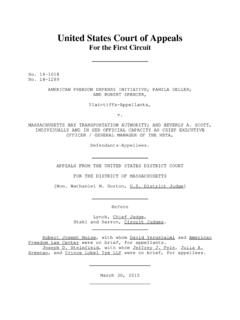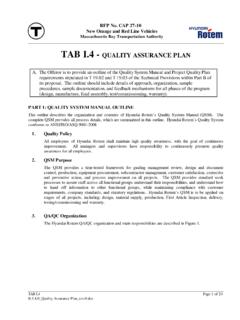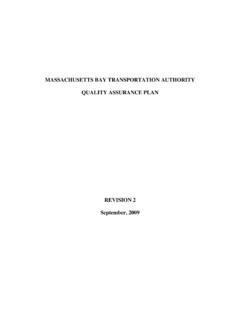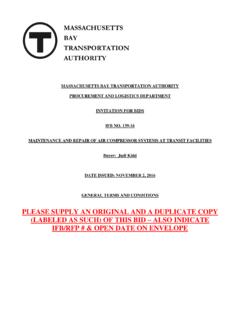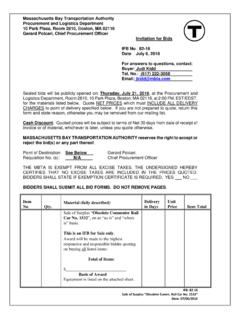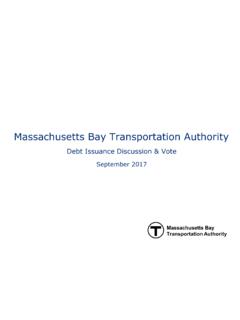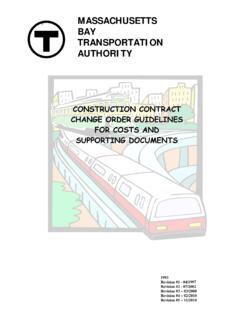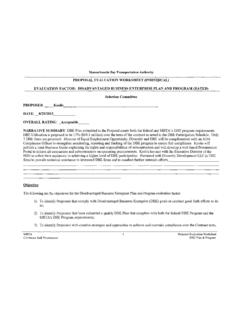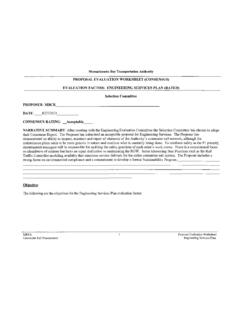Transcription of Improving Pedestrian Access to Transit - Safety
1 ImprovingPedestrianAccess toTransitAn AdvocacyHandbookBy WalkBostonWith Assistance from the Metropolitan Area Planning Council and theMassachusetts Bay transportation AuthoritySponsored by Federal Transit Administration, Livable Communities ProgramImproving Pedestrian Access to Transit : An Advocacy HandbookPrepared by WalkBoston, with assistance from the Metropolitan Area Planning Council and theMassachusetts Bay transportation authority . Sponsored by Federal Transit Administration,Livable Communities Program. 1998 This report was funded by the Federal Transit Administration as a LivableCommunities Project submitted by the Metropolitan Area Planning Councilof Boston, massachusetts . The phrase, livable community means a placewhere residents work, shop, go to school, enjoy recreational activities andget to medical and public service facilities with ease.
2 The communitysupports the many rich aspects of day-to-day of ContentsExecutive Summary ..vii1 Using Advocacy To Improve Transit ..12 Background of this Report ..9 Including an Overview of Boston Transit3 Community Involvement and Activism ..12 The Southwest Corridor4 Citizen Coalition Forms to Stop a Road-Widening Project Near Transit ..23 Ruggles and Tremont Streets5 Busy Streets and Pedestrian Access to Transit ..31 The Beacon Streetcar6 The Neighborhood Bus Stop Program: Launching an Advocacy Project ..41 Bus Service in Roxbury AppendicesWalkable Communities Pamphlet ..55 Glossary of Useful transportation Terms ..59 Bibliography ..65 The Participation Process ..66viiEXECUTIVE SUMMARYThis report is written for ordinary citizens not necessarily for transporta-tion or urban planning officials who advocate for public Transit and walk-ing.
3 It illustrates key steps that activists can take to ensure that mass transitsupports community needs and creates livable communities throughimproved Pedestrian Access . The authors present their personal experiencesin case studies that detail advocacy techniques and strategies. They alsoidentify some failures or setbacks. The report discusses several public tran-sit modes ( , bus, light rail, and subway) used in different kinds of com-munities (low-income urban neighborhoods, upper- and middle-incomeinner suburb). The authors are members of WalkBoston, a nonprofit organi-zation that promotes walking and Transit as means of report was funded by the Federal Transit Administration as aLivable Communities Project. The term livable describes a place that nur-tures the many rich aspects of day-to-day life.
4 Residents of a livable commu-nity can work, shop, go to school, enjoy recreational activities and get tomedical and public service facilities with ease. The report is written in a more personal vein than the standardconsultant report, because we believe that advocacy engages deep emotionaland intellectual energies. We use quotations and photographs that sharedetails of our experiences both frustrations and satisfactions. We believethat this approach communicates the advocacy process accurately, andteaches it LIVABLE COMMUNITIES IN GREATER BOSTONOur case studies are drawn from Transit projects in greaterBoston. Two of the four case studies deal with the ways advocates reacted totwo issues: Pedestrian fatalities on a busy street and a threatened street-widening project, initiated by public agencies, which would hinder pedestri-an Access to a major Transit station.
5 A third case study describes a projectthat evolved from contention into collaboration between neighborhoods andthe Transit agency, and ultimately transformed areas of Boston into desir-able, livable communities. The fourth case study deals with a proactiveeffort on the part of WalkBoston to increase bus ridership by creating busstops that are attractive, easy to walk to, and contain crucial bus route infor-mation. All four illustrate that advocates for Transit and livable communi-ties are the agents of change. Many times people in bureaucracies want toinstitute change, but are unable to do so. They look to advocates to suggestthe outrageous, to get media coverage, to create a stir. Back in their offices,these public officials can point to your advocacy as political pressure thatdemands a response.
6 They want you to come to public meetings, to write let-ters, to criticize. Your advocacy is vital to the success of public officials whowant to innovate and hopes these case studies will encourage you to seewhat can be done and what methods can be used to bring about public Transit buses, trolleys, subways, or commuter trains buildsand revitalizes Transit isn t effective unless people can get to it, easily andsafely. Sometimes local governments and Transit agencies don t do a verygood job of providing Pedestrian Access to Transit then it s up to averagecitizens to make it better. When average citizens work to change a situationand support a particular idea, that s advocacy. If you want to make it easierfor people to walk to Transit this report is for you.
7 It s written for averageAmericans, not for transportation experts. We hope you ll use it as a hand-book to help you advocate for good Pedestrian Access to report looks at different kinds, or modes, of public Transit (subway, light rail and bus) used in different kinds of communities (low-income urban neighborhoods, upper-and middle-income inner suburbs).It identifies key community involvement activities that advocatescan use to shape mass Transit to suit local residents and create Study FormatThe case studies in this report were written by different membersof WalkBoston, a Pedestrian advocacy group formed in 1990. They describereal-life situations the conflict, the alliances, and the compromises thatmake up the advocacy ADVOCACY TO IMPROVE Transit Never doubt that a small group ofthoughtful, committed citizens canchange the world, indeed, it s the onlything that ever has.
8 Margaret Meadadvocacy, n. The act of pleading for orsupporting 1 UsingAdvocacy toImproveTransit2 ACHIEVING LIVABLE COMMUNITIES IN GREATER BOSTONHere is an example of an advocate s experience:It is another steamy night in the middle of a heat wave,but we ve pulled ourselves together to come to thispublic hearing. The city is planning to widen a street ina dense Boston neighborhood. We can hardly believe it. This projectwill force residents to scurry across a seven-lane roadway with 5seconds of WALK signal time to reach a bus and subway the presentations begin we mill around, reassess-ing our strategy and saying hello to friends from so many previousadvocacy projects. We even exchange pleasantries with the propos-al s supporters.
9 The city s transportation engineer, who is part of theroad-widening team, says hello. She sees me as a familiar faceamong 100 hostile strangers. I warmly greet a man from the transitauthority; we are on opposite sides of this project, but we bothbelieve in the richness of diverse urban neighborhoods and havelabored for that shared goal in the love this drama of community life. Years ago, I was lone-ly, new to town, and without a lot of connections. I vowed to dosomething to meet more people. I had no idea my efforts would reapsuch a harvest. I know at least 20 people in this consultant for the road-widening team whispers to me. I wondered when WalkBoston would finally come out to oppose thisproject. I feel a twinge of guilt.
10 With minimal staff, we must rely onvolunteers to attend meetings and provide the technical expertisethat makes us credible. We are already spread so thin. I know we relate, I answer, but we re doing the best we can. He nods, Try tostick with it. The raucous meeting of community activists, state legisla-tors, public officials, and advocacy groups like ours goes on for sometime. We try to persuade the city to consider an alternative trafficplan. But, as at so many similar meetings, the results are inconclu-sive. The representatives of the state environmental agency decideto extend the public comment period on the road-widening. We willall need to write more letters, get the media s attention,band together and do what we can.








